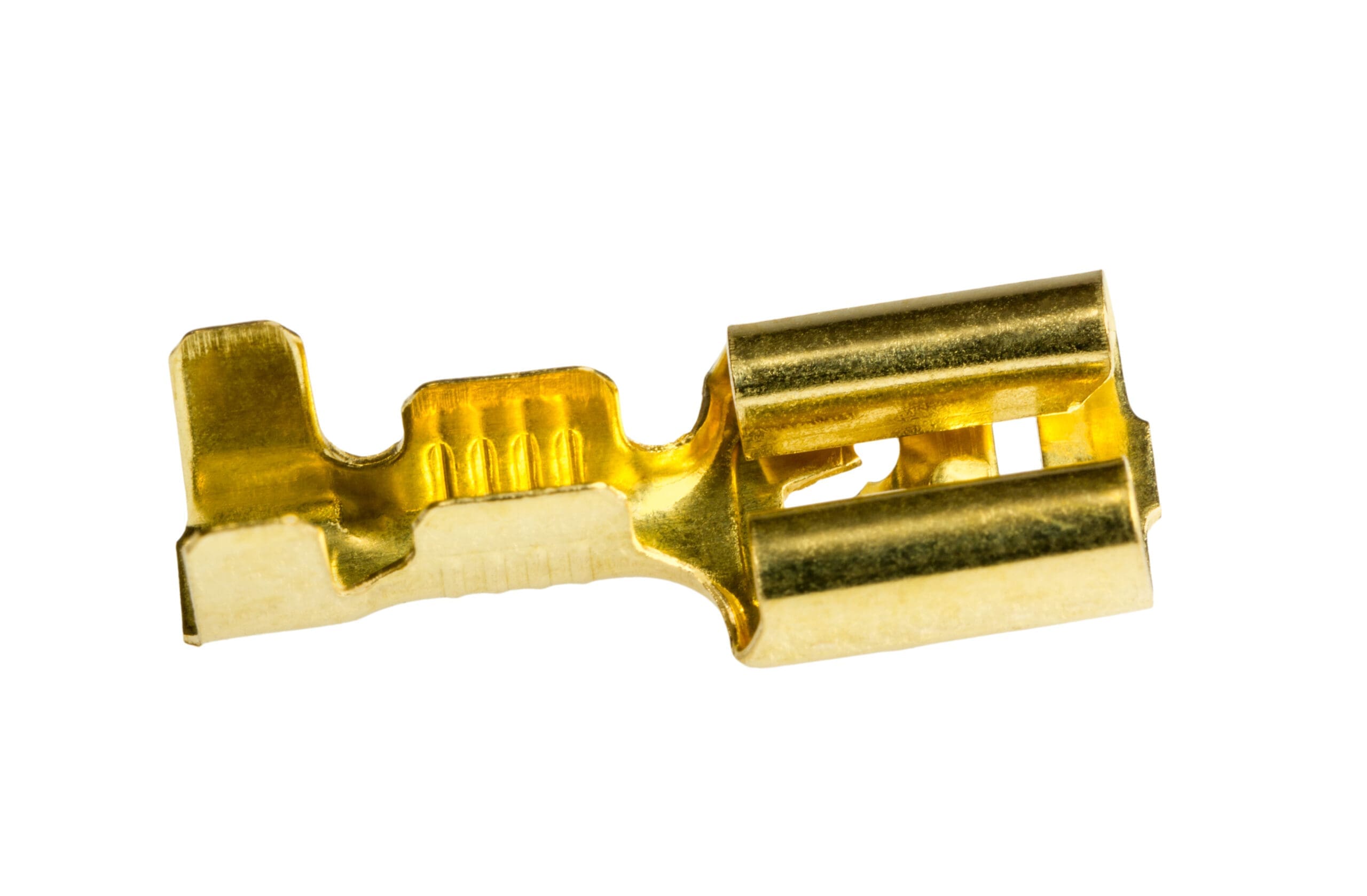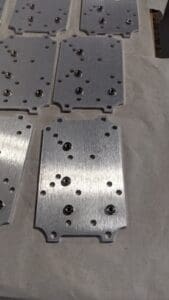Last updated on March 19th, 2025 at 08:17 am
Here’s an interesting bit of information: the number one reason ASM no-quotes a part is that it cannot be made using traditional sheet metal fabrication processes. Instead, it needs to go to a stamping house.
You aren’t alone if you are unsure of the difference between sheet metal fabrication and metal stamping. Here, we’ll describe these different processes and help you understand which approach is best for your parts.
Table of Contents
- 1 Traditional Sheet Metal Fab vs. Metal Stamping
- 2 Tolerance & Accuracy Differences
- 3 Start with a Design Consultation
- 4 Make ASM Your Precision Sheet Metal Fabrication Partner
- 4.1 Traditional Sheet Metal Fabrication vs. Sheet Metal Stamping FAQ
- 4.1.1 What are the main differences between sheet metal fabrication and metal stamping?
- 4.1.2 What types of parts are typically produced using metal stamping?
- 4.1.3 How can ASM help during the design phase to avoid unexpected costs?
- 4.1.4 What are the benefits of using a deep draw press in metal stamping?
- 4.1.5 What should I consider when deciding between sheet metal fabrication and metal stamping for my project?
- 4.1 Traditional Sheet Metal Fabrication vs. Sheet Metal Stamping FAQ
Traditional Sheet Metal Fab vs. Metal Stamping

Precision sheet metal fabrication leverages standard tooling and equipment to create a part’s shape and features. Metal fabrication shops are ideal for prototypes, one-off parts, and low-volume productions that don’t require custom tooling.
Metal stamping employs custom tooling and specialized equipment to create a part’s shape and features. Stamping houses are best for high-volume productions.
Fabrication equipment and capabilities
Metal fabrication shops provide cutting, punching, shaping, folding, welding, and custom fabrication. These powerful machines support ASM’s fabrication processes:
- Laser cutters. Our laser cutters achieve precise cuts with minimal material waste. We can handle even complex designs in various material types and thicknesses.
- Punch presses. The punch press employs a shaped die to quickly cut holes and other openings in your sheet metal material.
- Press brakes.The press brake uses a die to form sheet metal parts, performing bending and drawing processes with high precision.
- Welding machines. Our welding experts perform MIG, TIG, and spot welding with incredible accuracy, ensuring a strong, durable final product.
ASM’s additional capabilities include finishing, hardware insertion, and assembly services. An ITAR Registered Metal Fabricator, our metal fabrication shop commonly makes precision prototypes, enclosures, weldments, brackets, panels, frames, assemblies, covers, card cages, consoles, RF and EMI shields, busbars, chassis, cabinets, 19" racks, contacts, and more.
Stamping equipment and capabilities
In stamping, a single press applies a series of dies customized to the part’s various angles and features. Metal stamping machines can fill an entire room, with presses ranging in size from 20-6,000 tons. You’ll find machines like these in a stamping facility:
- Mechanical presses. Capable of progressive stamping, mechanical presses quickly and efficiently produce high volumes of simple, shallow-formed parts from sheet metal coils.
- Hydraulic presses. Slower than mechanical presses, hydraulic presses produce deep, complex shapes in parts with extensive material flow.
- Mechanical servo presses. With the flexibility of a hydraulic press and the speed of a mechanical press, the mechanical servo press offers fine controls, an array of dies, and varying production speeds.
- Deep draw metal stamping presses. Also known as a “transfer press,” the deep draw press applies extreme pressure to draw a metal blank into a die and form the complex component.
Metal stamping houses make parts such as fasteners, torsion springs, hand tools, valves, flanges, rotary joints, gas fittings, and more.
Tolerance & Accuracy Differences
One of the most critical factors in determining whether traditional sheet metal fabrication or metal stamping is the right process for your part is the level of precision required. Tolerances dictate how accurately a part must be produced to fit within an assembly, and each method has its own capabilities and limitations.
Tolerance Capabilities: Fabrication vs. Stamping
Sheet Metal Fabrication
- Achievable tolerances typically range from ±0.005” to ±0.015”, depending on the cutting, bending, and welding processes used.
- CNC laser cutting and punching offer high precision, but bending can introduce slight variances due to material springback.
- Welded assemblies often require additional machining or post-processing to meet tight tolerances.
Metal Stamping
- Stamping can achieve much tighter tolerances, often as precise as ±0.001” to ±0.005”, particularly for complex geometries.
- Since stamping tools are custom-made, every feature is formed with extreme repeatability and minimal deviation.
- Progressive dies allow for high precision even in high-volume runs, reducing the need for secondary operations.
Impact of Process Variables on Accuracy
Springback & Material Deformation
- In fabrication, springback during bending can slightly alter the final dimensions, requiring compensations in design.
- Stamping, especially deep draw stamping, controls material flow to achieve consistent shapes and angles without manual adjustments.
Heat Distortion in Welding
- In fabrication, welding introduces heat that can cause warping and slight dimensional changes, requiring additional steps like stress relief or machining to maintain accuracy.
- Stamping avoids welding in most cases, ensuring dimensional stability across high-volume production.
Feature Repeatability
- Sheet metal fabrication offers flexibility, but slight variances occur between parts due to manual setups and adjustments.
- Stamping provides near-identical parts in mass production due to fixed die tooling, ensuring higher repeatability across thousands of units.
When to Choose Fabrication vs. Stamping Based on Tolerance Needs
- If your part requires tight tolerances, high repeatability, and minimal post-processing, stamping is often the better option.
- If your design allows for slight variations, requires small batches, or is frequently revised, fabrication provides the necessary flexibility.
Key Takeaway
For low-volume production, sheet metal fabrication delivers excellent accuracy, but secondary machining may be needed to achieve high precision. For high-volume production, metal stamping’s custom tooling ensures superior consistency and tight tolerances at scale. Understanding these differences will help you optimize your manufacturing approach based on precision, cost, and efficiency.
Start with a Design Consultation
The decision between stamping and sheet metal fabrication begins with a design discussion. The ASM team will assess your design and recommend changes to improve the part’s manufacturability. If our precision metal fabrication services aren’t the right fit for your production goals, we’ll point you in the right direction.
Design considerations for sheet metal fabrication
Precision sheet metal fabrication is the way to go if your part includes traditional formed features like embossments and louvers. Remember, however, that the feature’s depth can’t significantly exceed the sheet metal’s thickness.
Get help designing fabrication-friendly parts!
- Watch our SOLIDWORKS video series for expert sheet metal tips
- Visit our CAD library for FREE embossment and louver templates
Design considerations for stamping
With a deep draw press, a stamping house can bypass the depth maximums that limit a fabricator. Stamping can also achieve precise bends in tiny parts under 1“.
How are these features possible? In stamping, a custom tool is made for every feature in the part’s design, enabling impressive precision on parts of every size. However, stamping tools can cost tens of thousands of dollars each, making the approach cost-prohibitive for most small or mid-sized orders.
Avoid this major design mishap
When a customer requested a quote for a small quantity of single-bend brackets, we quickly discovered an unusual challenge. Unlike the typical straight bend on most brackets, this bracket incorporated a curved bend that was impossible to achieve without a custom $13,000 tool. Predictably, the high cost of the custom tool sent the customer back to the drawing board.
Avoid unexpected costs by talking with us during the design phase. We’ll help you identify design elements that could create preventable problems further down the line.
Make ASM Your Precision Sheet Metal Fabrication Partner
From design consultations to expedited delivery, our experts give you the guidance, quality, and speed you want and need.
Tap into our FREE resources for engineers, or kickstart your next project and request a quote through our secure portal.




